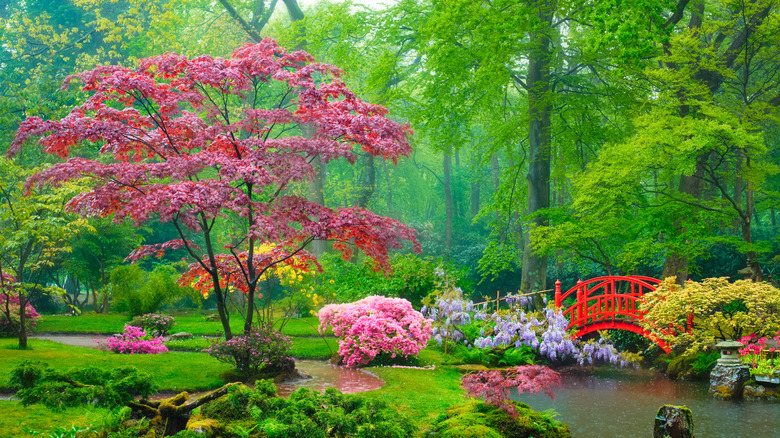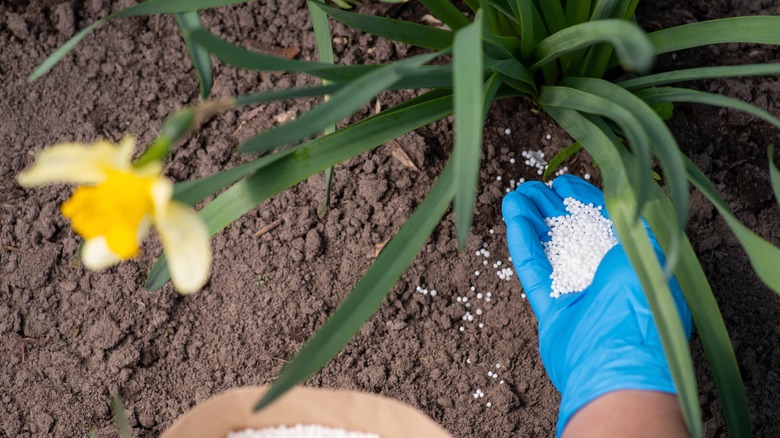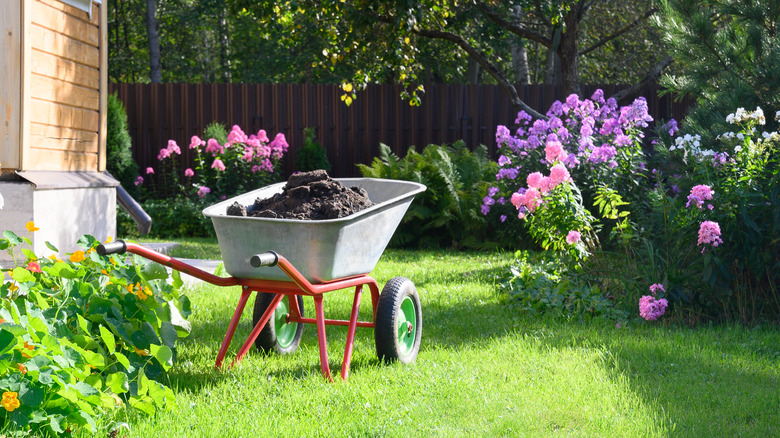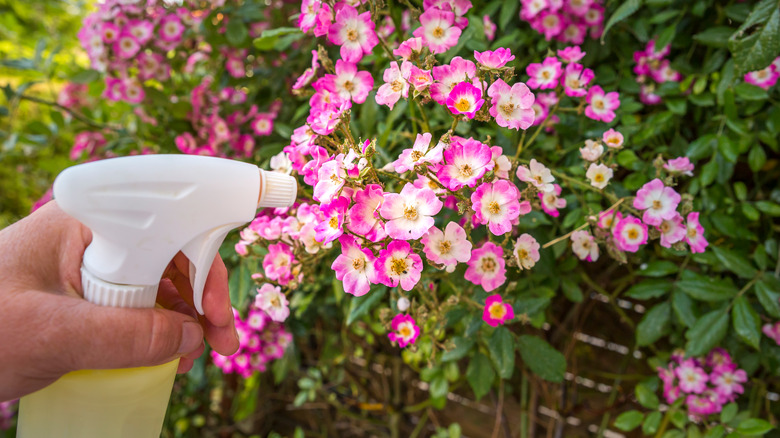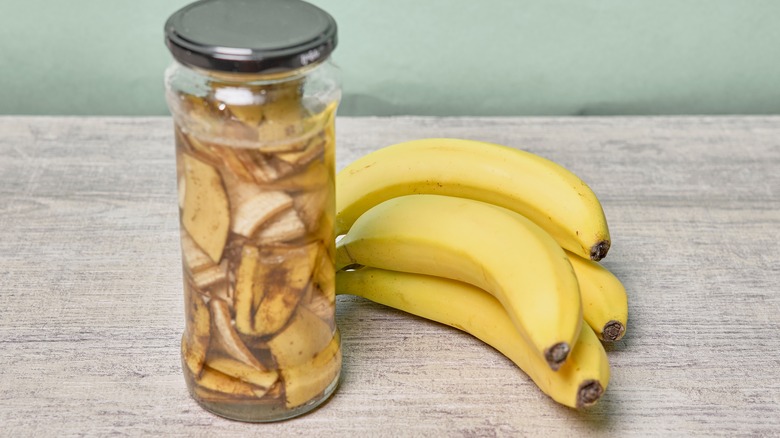How To Choose The Perfect Flower Fertilizer
There are three key ingredients for beautiful blooms in your home and garden. The sun's light powers plants; giving them enough energy to produce flowers. The correct level of water sustains them and their processes throughout the growing period. Nourishment from the soil provides essential nutrients and minerals, other than the carbon, oxygen, and hydrogen that come from the air and water (via University of Minnesota Extension). However, many of these nutrients can become depleted, either through being washed out by watering or from previous plants making use of them. This is why it is important to fertilize your flowers.
That being said, there are a number of different variables to consider when choosing which fertilizer to use. Firstly, fertilizer is often differentiated by ratios. These refer to the three major plant nutrients in fertilizer, which are nitrogen, phosphorus, and potassium (N-P-K), per Garden Myths. If your soil is already particularly deficient or high in any nutrients, you may need an unusual ratio or a formula with specific micronutrients to balance it out.
In most situations, the decision of which flower fertilizer to use comes down to how often you want to apply it, whether you want to use inorganic chemicals on your plants or not, and whether you are interested in making homemade fertilizer. Continue reading for a discussion of each of the best types of fertilizer for flowers, and an easy recipe for a homemade option you can try today.
Classic complete fertilizer
Just like animals, all plants require certain things to grow healthy and strong. The healthier and more vigorous the plant, the more vibrant and long-lasting floral display it can muster. Classic fertilizers, or general all-purpose options, are formulated in a ratio that will suit most gardens and plants. Plants need nitrogen and potassium for leaf growth and a healthy, well-developed root and transport system.
Some bloom boosting formulations are marketed as being better for flowering plants due to their elevated levels of phosphorus, however, per the University of Massachusetts Amherst, in most non-agricultural planting situations, the soil already has as much as it needs. The university goes on to explain that too much phosphorus can actually harm your plants. Moreover, using fertilizers with elevated levels of phosphorus isn't only wasteful or a marketing gimmick; excess phosphorus from your beds can wash into water sources and inhibit the growth of aquatic plants in nearby streams and rivers. This disrupts the balance of local waterways by encouraging algae to grow, which is very harmful to other plants and wildlife if left unchecked, reports the EPA.
If you suspect you may have low levels of phosphorous in your garden or yard, do a soil test. When you find yourself in the market for a flower fertilizer, don't be tempted by fancy branding. A classic formula will probably be all your blooms require to thrive.
Organic natural fertilizers
Using chemical fertilizers is a simple equation. You figure out what nutrients the plant needs to grow well, you give the plant those nutrients, and unless you missed something, the plant grows well. Organic fertilizers aren't quite that simple. According to Get Busy Gardening, where chemical fertilizers feed the plant, organic, natural fertilizers feed the soil. This is a slower process, but one that, in the long term, will have major benefits for both your plants and your garden as a whole. It's also a gentler way to fertilize a garden. You can add a lot of organic fertilizer once or twice a year and have fantastic soil fertility whilst running no risk of burning the roots or stems of your plants.
Chemical fertilizers cannot be applied so liberally, so they mostly need more regular application. Even so-called complete chemical fertilizers don't have the range of attendant benefits that organic fertilizers do, such as improving your soil's ability to absorb and retain moisture, per Gardening Tips.
Organic fertilizers essentially come from manure and compost. This means that you can turn garden debris and kitchen leftovers into natural fertilizer to use in your garden using just a compost bin and time. The idea of turning waste into a free resource to make your flowers pop is a very attractive one, and this is perhaps why organic fertilizer is the trendiest thing to use on your plants.
Foliar fertilizers
Plants certainly appreciate a long-term supply of fertility in the soil, however, they can absorb fertilizers in a liquid form much faster. This is called foliar feeding and it is particularly useful for plants that are undergoing some kind of stress, or for when they are in a crucial growth stage, such as bud formation, notes Longfield Gardens. There is evidence, according to a 2021 study published in Plants (Basel), that flowering plants treated with foliar fertilizers have increased growth, longer life as cut flowers, and accelerated propagation potential.
Liquid, spray-on fertilizers can be chemically or organically based. Chemical foliar fertilizers are made from salts that may harm beneficial soil micro-organisms, whereas organic foliar fertilizers contain a more balanced mix of micronutrients, amino acids, and plant hormones that play a key role in invigorating plant growth, according to Savvy Gardening
Just as too many chemicals can burn a plant's roots, foliar fertilizing your plants while they are under stress can cause them more stress. If you've got some drooping plants that you want to perk up with foliar feeding, give them a good watering first, and wait a few hours before applying fertilizer so that the plants are in the best state to take advantage of it.
Amendments
Technically, amendments are not fertilizers. Fertilizers directly affect plant growth by balancing nutrients. Amendments, or soil conditioners, indirectly help with plant growth by improving the physical properties of the soil (via University of California). In practice, they are something you might need to buy in a bag and mix into your soil to make your flowers prettier, so they definitely deserve inclusion in this list.
According to the University of Georgia, most annual flowers prefer moist, well-draining soils. Different amendments help attain this goal by improving either the soil's ability to stay moist or to drain well. If the soil doesn't drain well (often a symptom of too much clay), the roots will effectively drown since they require oxygen to survive. If the soil drains too well, however, the plant will dry out quickly, and more frequent watering will also wash out more and more of the soil's nutrients.
Lime and sulfur can be used to adjust the pH of the soil up or down, depending on what you need. Sand, gravel, perlite, or other dry, inorganic aggregate material can be mixed into or underneath flower beds that have very poor drainage. These also help with plants that are adapted to drought-like conditions such as succulents. The best amendments to make moist, well-draining soils are compost or other organic matter, says the University of Maryland Extension. Aim for somewhere between 5% and 10% organic matter by volume in your flower beds.
Homemade banana peel fertilizer
Surprisingly, if you eat bananas, you might be in possession of the perfect flower fertilizer already. Bananas are a great sports snack because of their unusual nutrient makeup, and their peels work in just the same way for flowers. Potassium is the key in both cases, and according to the Cape Gazette, banana peels are over 40% potassium. Optimal potassium levels create plants with robust transport systems, meaning strong stems that rapidly move water and nutrients from leaf to root and back. This is crucial for flower growth, and bananas are also packed with other micronutrients that aid in photosynthesis and chlorophyll production.
Another reason banana peels are good for the flower gardens is that they do not contain nitrogen. Whilst plants need nitrogen to grow, too much of it in the soil encourages them to put on green leaves, rather than berries or fruits, which lead to flowers.
Homemade banana peel fertilizer is also super easy to make! You can simply bury banana peels around flowering plants if you like, but, per Crema Joe, if you soak cut up banana peels in a ratio of twice as much water as peels for 2 to 3 days, the resultant liquid can be strained and used as a liquid fertilizer. The fermented peels can then be added to compost or mixed into the flower beds directly.
